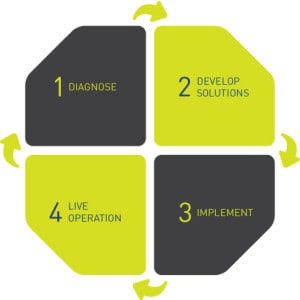
The airport world will be different – perhaps for many years. However, running a business and an airport is about handling the downside and taking opportunities when and where they are available – otherwise your competitors’ will.
It is clear that airport operators must look at their businesses in a new light. No longer is growth guaranteed. No longer is income from Airlines, Parking, Duty-Free, Retail, Food & Beverage guaranteed. The fixed overheads including your Licensing costs continue to run. Revenue and profits will be squeezed.
Planning for Airport Restart, Recovery & Growth
The Restart will come at some time and the resources expended to stay open need to be matched against the demand curve in a way never done before by any Airport. No Airport has run at 40% or 50% capacity and built from that point. The exercise is totally new and needs a new mindset by the management team.
The management skills to run the airport need to be re-aligned to focus on commercial contracts, cost savings and overall efficiency while coping with erratic and rapidly changing flight schedules. The management team need to look as never before at the commercial contract base and operational cost base of the airport to survive. They also need to keep their stakeholders and Unions in agreement.
Airport Planning at a Strategic Level
The senior management of the airport will be working with government/local authorities and all stakeholders and airlines, to restore flights, setting out the strategy to identify segments of the markets and countries that are likely to recover first. There will be stiff competition between airports to retain airlines and open routes. The marketing ability of the airport will be tested to the full.
Covid-19 – Health and Safety – Passengers and Staff
To keep passengers and staff safe and adhere to COVID-19 rules, airports are providing social distancing and where possible touchless interaction and enhanced cleaning procedures. This is as much about giving passengers the confidence that the airport environment is safe and that the airport is safer than any rival.
Reduce Overheads Costs
Review your space, facilities and services with the aim of reducing or closing were necessary to the best forecast available. Negotiate flexibility in opening hours and staff numbers and start to plan for the whole Airport community. Look at the Airport overhead as a whole, not in isolation from each other.
Business Airport Efficiency
Now is the time to consider re-engineering processes including touchless technology, CUPPS and next-generation security. Now is the time to think about different approaches in your business to ensure that it is flexible, agile and above all running at maximum efficiency.
Disruptive Technologies
The list of disruptive technologies being adopted is ever longer:
- Blockchain for passenger data
- 3 D printing for maintenance components or as a passenger service
- Digital twins to parallel track your day to day operations
- Robotic assistance – for the movement of goods, cleaning, movement of people with reduced mobility
- Internal positioning systems to facilitate robotics
- Apps for facilities management and cleaning routines.
- Apps for booking staff access through Security Control Posts
- Remote monitoring of equipment to sense overheating and vibration or the filling of waste bins
Renegotiate Contracts
Working with stakeholders to re-negotiate contracts to recognise reduced and variable demand against agreed service levels. For example
- Parking
- Duty-Free
- Retail
- Food & Beverage
- Cleaning
- Waste Management
- Bus transfers
- Handing VIP’s
Can separate contracts be fused together to create efficiency savings and one point of contact? Can simple process re-engineering allow contracts to be merged?
Share the pain and take a fresh approach to improve efficiencies for the benefit of all stakeholders and look at protecting key revenue streams and developing new revenue opportunities for all.
The Airport vs the Airline
We know from our 20-year experience of modelling capacity and demand there is a constructive tension between the airport and airline. In the current environment, an airport may want to close a terminal or shut a whole section of the airport to save money which must be negotiated with the airline. Check-in desks may be reduced, particularly with the use of CUTE or CUPPS, but that erodes the airlines ‘footprint’. The relationship needs to be one of mutual benefit.
Improve the Use of Data
Traditionally data is an area where there is mutual suspicion between stakeholders. A new reality demands that aeronautical and non-aeronautical stakeholders work closely together to share data. Some progressive airports are using flight data in advance to aid in planning and managing the demand and running the business as efficiently as possible. The Airport Collaborative Decision Making (A-CDM) and Airport Planning and Operational Control Centre (APOCC) approach is now gaining acceptance in many airports.
Open and transparent communication is essential to developing more business for the whole airport community. Simple and rapid modelling allows a diagnostic and rebalances of the complex interdependent systems.
Facts not Opinions
Planning for the restart of an airport requires the classic – diagnostic, redesign and implementation. This is the approach AiQ take when solving complex airport problems, as seen in the below process model.

Assess the resources needed at various levels of service and therefore the value of the contract at these breakpoints.
A critical part of this work is in demand dependent functions where the activity may reach peaks and creativity is needed to design shift patterns to cover these peaks while maintaining acceptable utilisation of staff and service level to the passenger.
In the next blog, we will show how AiQ is working with airports to introduce efficiency savings ‘Below the Wing’ including contract negotiation and disruptive technologies.
Airport Efficiency
Our award-winning team at AiQ have first-hand knowledge of airport systems and stakeholders, working in airports around the world for 20 years. Not only do we have the technical airport knowledge but also the commercial knowledge to support airports during these challenging times. AiQ Consulting was born from a business management consultancy that directors Adrian Todd and Derek Allen founded and operated for 30 years. This combination of the vast airport and consultancy experience teamed with our data analysis, forecasting and modelling software provides airports with cost-effective planning and operational efficiency experts to assist your airport recovery. Contact us today to find out more about our Airport Efficiency Service.

